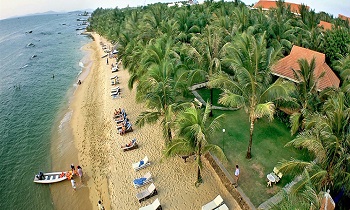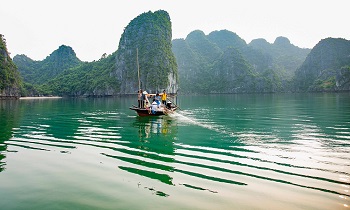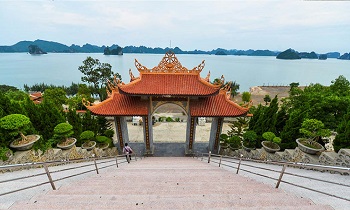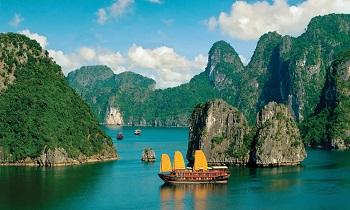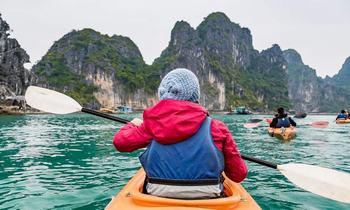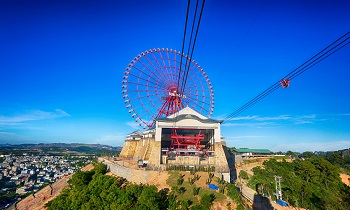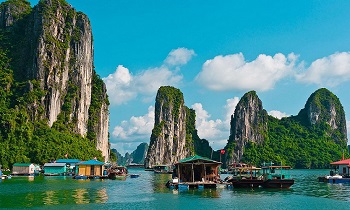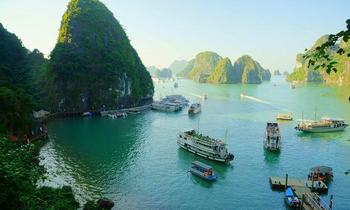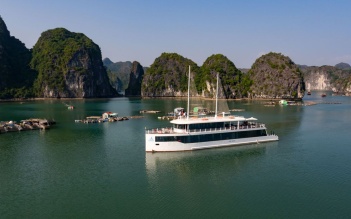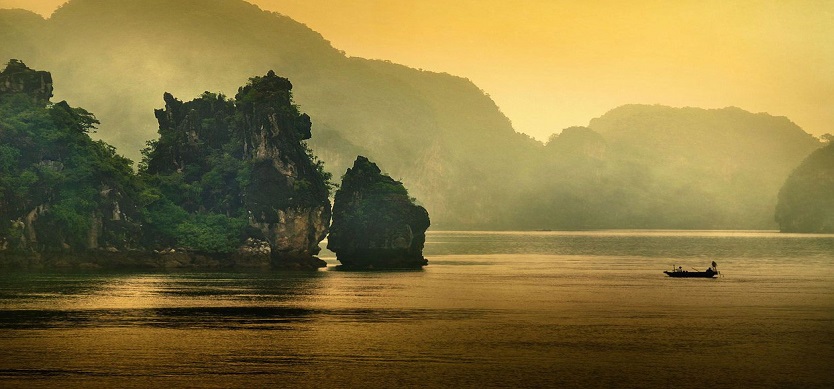
Where is Halong Bay on Vietnam tourist map
Being a spectacular seascape, Halong is one of the most famous tourist destinations in Vietnam. With the breathtaking natural landscapes and the exciting outdoor activities, Halong is always on the bucket list of any sea lovers or authentic travelers. This article is about where Halong is in Vietnam map and our suggestion of where to visit when setting foot on Halong.
Location
Halong Bay which is situated in Northeastern Vietnam is 102 miles (164 km) from Hanoi to the Southeast and about 40 kilometers from Hai Phong to the Northeast. Located on the northwest coast of the Gulf of Tonkin, with the area of about 1,553 square kilometers Halong bay cover the large area of Yen Hung district, Halong city, Cam Pha town and Van Don district. Halong Bay shares the border with Lan Ha Bay to the Southeast, Halong city to the North and Bai Tu Long Bay to the west.

Halong Bay
Geographic location
Halong Bay is located in the northeast of Vietnam in Quang Ninh province, 165 km from Hanoi capital. Halong Bay covers an area of 1,553 km2 including 1,969 islands (of which 980 islands have names). North and Northwest extend from Quang Yen town to the end of Van Don district's inland waters; In the southeast and the south, it borders on the west bank of the Gulf of Tonkin, in the southwest borders on Cat Ba island (Hai Phong city).
History
Halong Bay is the location of 1,960–2,000 islets and most of them are limestones. The core site has an area of 334 km2 with the number of islets coming up to 775. The limestone has undergone 500 million years of formation in different weather conditions as well as environments. Under the effect of the tropical wet climate, the karst in this bay has continuously evaluated for about 20 millions of year. The geo-diversity of the environment in the area has resulted in biodiversity, including a tropical evergreen biosystem, and oceanic biosystem. Halong Bay is the residence of 14 endemic floral species and 60 endemic faunal ones. The waters and tropical jungles are the home to various marine and land creatures, mammals, fish, and birds, reptiles.
The historical researches have shown the evidence of the presence of the prehistoric human in this site tens of thousands of years ago. Especially Hoabinhian culture (10,000 years ago). With various artifacts found in Dau Go Cave, Bai Tho Mountain, and Bai Chay, Halong specific culture highlights important events in Vietnam history.
500 years ago, Nguyen Trai paid a compliment to the beauty of Halong Bay in his poem Lo Nhap Van Don, in which he described it "rock wonder in the sky". In 1962, Halong Bay was listed in the National Relics and Landscapes publication by the Ministry of Culture, Sports, and Tourism of North Vietnam. In 1994, Halong Bay’s core zone was listed as a World Heritage Site.
There are two similar legends about the origin of the bay, which are reflected in its name. According to the first legend, a dragon stomped on the earth so powerfully that mountains collapsed, forming huge valleys that soon filled with water. Only the peaks of mountains which are the present rocky islands of Halong Bay—remains to stay above the surface. Another folklore mentions a dragon whose large tail ripped off the earth, resulting in valleys and crevices. When the beast jumped into the nearby water zone, these valleys soon were flooded. Both versions are impartially associated with the present legend of Tarasque, a marine creature which is referred to as the dragon is believed to inhabit in the bay.
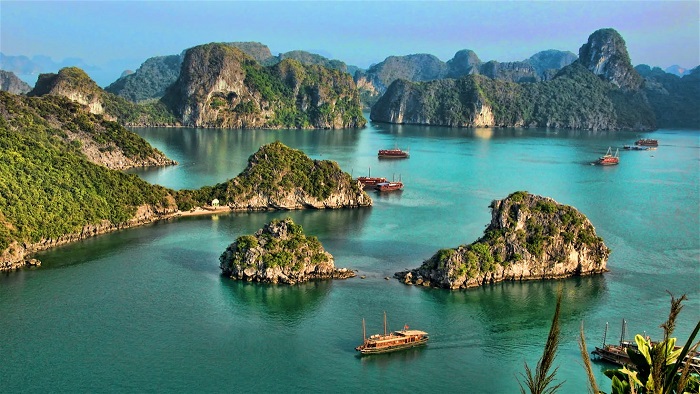
Halong Bay
Climate
Halong Bay has a tropical climate with hot and humid which is divided into 2 main seasons including winter: from November to March of the following year, the average temperature is 15oC - 20oC; and summer: from May to September, temperature is average 26oC - 27oC) and 2 transition seasons (Spring in April, Fall in October, average temperature in 18oC - 19oC).
The average annual rainfall is from 2,000 mm - 2,200 mm.
International honors
Halong Bay is twice recognized by UNESCO as a World Natural Heritage.
- The first time: On December 17, 1994, the 18th Session in Phuket, Thailand, the World Heritage Committee recognized Halong Bay as a World Natural Heritage list with global outstanding value and the aesthetic aspect according to the criteria (vii) of the International Convention for the protection of the world's natural and cultural heritage.
- The second time: On December 2, 2000, at the 24th Plenary Meeting in Cairns, Queensland, Australia, the World Heritage Committee recognized Halong Bay as the 2nd World Natural Heritage. according to the standard (viii) on geological value - geomorphology.
Tourism's potential
With outstanding values in the landscape, geology - geomorphology, abundance and richness in ecology, cultural history, Halong Bay is a place with favorable conditions for tourism development. Currently, there are many types of tourists to choose from:
- Sightseeing tours: Tourists sitting on cruise ships or boats admire the green islands, many shapes floating on the water arousing rich, romantic, poetic imagination or discovering the beautiful and mysterious caves, unique ecosystems, delight in swimming in the clear blue water of Halong Bay. Indeed, it was a wonderful, memorable time.
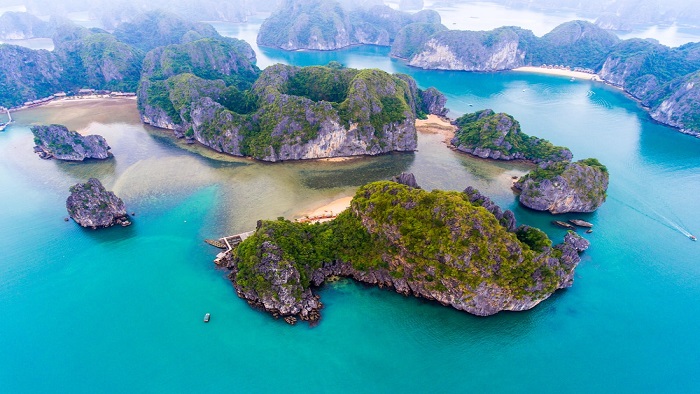
Vung Vieng fishing village
- Cultural tourism: Guests have the opportunity to visit archaeological sites - evidence of ancient Vietnamese life from 18,000 to 3,500 years ago in some caves. Furthermore, touching the snails sweet has existed for thousands of years in the sea, proving the sea invasion of the continent, and experiencing the unique marine culture of the Halong fishing people such as love songs, sea chores, customs, beliefs, festivals of Halong fishermen.
- Adventure travel: Guests will have the feeling of comfort and freedom when participating in water-wave adventure games like driving a water jet, banana buoy, kayaking with great enjoyment or climbing to collected into the sight of the majestic, sparkling and spacious landscape of Halong Bay
- Entertainment, and shopping: Fuller for Halong excursion when visitors are relaxing, sunbathing in the peaceful space of the bay, or visiting the cultivating and pearl processing area and choosing for themselves the Souvenirs made by the essence, distilled from the sea of Halong Bay pearls.
- Ecotourism: It will be an unforgettable experience for visitors to take a boat trip to visit some flooded caves (Karst cave) on Halong Bay, participate in the experience of mangrove planting, study and examination. breaking the beauty of endemic flora populations on Halong Bay.
Halong is truly a gift that Nature blessed for Vietnam. Now you know where Halong is and do not hesitate to explore Bai Tu Long Bay, Lan Ha Bay, Vung Vieng fishing village, Sung Sot cave, Ban Chan beach via Halong Bay tours to get the marvelous moments. Once you have visited these places, they will certainly leave a strong impression on you.

